A Novel Ingestion Strategy for Sodium Bicarbonate Supplementation in a Delayed-Release Form: a Randomised Crossover Study in Trained Males
- PMID: 30680463
- PMCID: PMC6346694
- DOI: 10.1186/s40798-019-0177-0
A Novel Ingestion Strategy for Sodium Bicarbonate Supplementation in a Delayed-Release Form: a Randomised Crossover Study in Trained Males
Abstract
Background: Sodium bicarbonate (NaHCO3) is a well-established nutritional ergogenic aid, though gastrointestinal (GI) distress is a common side-effect. Delayed-release NaHCO3 may alleviate GI symptoms and enhance bicarbonate bioavailability following oral ingestion, although this has yet to be confirmed.
Methods: In a randomised crossover design, pharmacokinetic responses and acid-base status were compared following two forms of NaHCO3, as were GI symptoms. Twelve trained healthy males (mean ± SD age 25.8 ± 4.5 years, maximal oxygen uptake ([Formula: see text]) 58.9 ± 10.9 mL kg min-1, height 1.8 ± 0.1 m, body mass 82.3 ± 11.1 kg, fat-free mass 72.3 ± 10.0 kg) underwent a control (CON) condition and two experimental conditions: 300 mg kg-1 body mass NaHCO3 ingested as an aqueous solution (SOL) and encased in delayed-release capsules (CAP). Blood bicarbonate concentration, pH and base excess (BE) were measured in all conditions over 180 min, as were subjective GI symptom scores.
Results: Incidences of GI symptoms and overall severity were significantly lower (mean difference = 45.1%, P < 0.0005 and 47.5%, P < 0.0005 for incidences and severity, respectively) with the CAP than with the SOL. Symptoms displayed increases at 40 to 80 min post-ingestion with the SOL that were negated with CAP (P < 0.05). Time to reach peak bicarbonate concentration, pH and BE were significantly longer with CAP than with the SOL.
Conclusions: In summary, CAP can mitigate GI symptoms induced with SOL and should be ingested earlier to induce similar acid-base changes. Furthermore, CAP may be more ergogenic in those who experience severe GI distress with SOL, although this warrants further investigation.
Keywords: Acid-base balance; Bioavailability; Exercise-induced fatigue; Extracellular buffer.
Conflict of interest statement
Ethics Approval and Consent to Participate
Ethical approval was granted by the University Research Ethics Committee (URESC17-NH01), and each participant provided informed consent prior to commencing the study (see methods section).
Consent for Publication
Each participant provided informed consent for the results of this study to be published.
Competing Interests
The authors, Nathan Philip Hilton, Nicholas Keith Leach, S. Andy Sparks, Lewis Anthony Gough, Melissa May Craig, Sanjoy Kumar Deb, and Lars Robert McNaughton, declare that they have no competing interests.
Publisher’s Note
Springer Nature remains neutral with regard to jurisdictional claims in published maps and institutional affiliations.
Figures




References
-
- McNaughton LR, Gough L, Deb S, Bentley D, Sparks SA. Recent developments in the use of sodium bicarbonate as an ergogenic aid. Curr Sports Med Rep. 2016;15:233–244. - PubMed
LinkOut - more resources
Full Text Sources
Other Literature Sources
Miscellaneous

